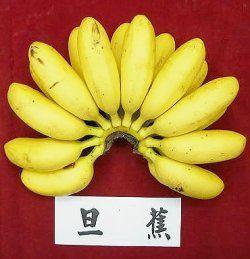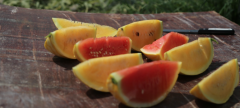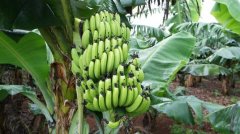Introduction of banana varieties: what is the difference between Dan banana and Bei banana? What are the morphological characteristics?
For those of you who like to eat bananas, do you know that the planting technology of bananas is relatively simple? what about the two banana varieties, Dan banana and Beijiao? What are the characteristics and differences between these two kinds of bananas? Let's have a look!
Dan banana is also known as sweet banana, Pisang Mas (Malaysia), Amas (Philippines), Gongjiao (Vietnam), etc. Thailand calls it KluAi Khai,Khai, which means "egg". Dan banana is one of the most important cultivated species in Thailand and Malaysia. Danjiao is the most famous in the Gan Mengbi region of north-central Thailand.
The main characteristic of "Dan banana" plant is that the pseudostem is turquoise and has obvious brown patches. The plant is about 250cm high, the leaf is yellowish green, and the petiole is smooth and not waxy. The yield of Dan banana is medium, and the fruit room is short. The yield per plant is about 713 kg and 6%. It can be harvested about 11 months after planting. Its fruit refers to short and round, unripe turquoise, ripe golden yellow, so Malaysia called it "Pisang Mas", Mas is the meaning of gold. The pericarp is very thin, the flesh is soft and smooth, orange-yellow, high sweetness and slight aroma, it should be noted that the banana should not be overripe when eaten.
According to the study, Danjiao may be resistant to the first physiological race of yellow leaf disease, but not to the fourth physiological race. When planting, we should pay attention to the prevention and control of fruit flies and flower thrips, so as not to damage the fruit room. Dan bananas were introduced in the Japanese occupation era, but farmers in Taiwan have never planted them, so now there is not much planting in Taiwan. According to the market trial market response survey, it is very popular with consumers and has the potential for domestic sales.
Bei Jiao: "Bei Jiao" is a traditional and excellent cultivated species in Taiwan, which was introduced from South China. It has been planted in Taiwan for 250 years. It belongs to the Chinese banana line (Giant Cavendish). It is the most important and widespread cultivated variety in Taiwan. It is the most widely distributed among all banana varieties planted in Taiwan, but it is still the most widely cultivated in the south and is the most important domestic and foreign variety in the province.
The pseudostem of Beijiao is slightly cylindrical and greenish brown. The stem height of the new plant is about 270-300 cm, which is 25-30 cm shorter than that of Xianren banana. It develops rapidly and can be harvested about 12 months after new planting. It is quite resistant to moisture, but it is not allowed to soak in water all the time. Generally speaking, it has a wide adaptability, but it is more vulnerable to wind damage because of its tall plants. The male bud of Beijiao is purplish red, and some bracts will remain on the flower axis. The petiole and leaf length are shorter than that of Xianren banana. The average leaf length of the first generation is 201.07 cm, and that of the second generation is 222.59 cm, which is 20 cm shorter than that of Xianren banana. The leaf shape ratio (leaf length / leaf width) was smaller than that of Xianren banana, with an average of 2.42 to 2.53 (more than 2.6). The unripe fruit is green, turns golden after ripening, the flesh is light yellow, the meat is delicate, sweet and fragrant, and the quality is excellent, especially from March to June. The fruit generally weighs 25 to 30 kilograms, and under good management, it can reach 30 to 50 kilograms, with an average of 8 hands. the fruit finger is 20 centimeters long and slightly arched in shape. it takes about 12 months from planting to harvest, which is 15 days shorter than the fairy banana, but the yield is slightly lower than that of the fairy banana. It will be infected with Panamanian disease in the province, and it is not resistant to yellow leaf disease, so it is not suitable to be planted in the disease garden.

- Prev

Open field watermelon new varieties golden melon watermelon, golden melon watermelon what are the colors of the two kinds of flesh
Introduction of new varieties of watermelon, do you know a kind of watermelon called golden melon, this kind of watermelon, the skin is golden, so we call it golden melon. You can't imagine that there are two colors in the flesh of golden melons, one is yellow soil, and the other is yellow soil.
- Next

Banana species and varieties: the planting history of Taiwan Xianren banana and dwarf banana is long, is banana disease resistant?
Banana yellow leaf disease is a serious disease. If you encounter this disease, you must deal with it in time. Let's take a look at the characteristics of Xianren banana and dwarf banana. Xianren banana: "Xianren banana" is a bud variety of "Beijiao". Bamboo in Taichung in 1989
Related
- The first cup of black tea in spring, the flavor and history of tea gardens in Kenya, Africa
- The computer can not only choose potatoes, but also grow tea rice. AI will grow winter oolong tea champion.
- It is not only the inflated tea bitten by insects, but also engraved with the four seasons tea in Beipu.
- The Oriental Beauty Tea Festival in Zhuxian County takes the stage at the weekend to experience the plus-size feast of oil tea.
- & quot; Oriental Beauty Tea & Exploration of Emei in Hsinchu, the hometown of quot;
- The new variety of strawberry "Tainong 1" dessert is the first choice with mellow aroma. Crimson gorgeous
- History of Tea in Taiwan: from Wild Inner Mountain to Export Tea Garden
- Two types of Taiwan Oriental Beauty Black Tea won the British three-Star Award for Childhood Tea Xiang Zhang Jiaqi changed from pilot to champion tea maker.
- Banana species and varieties: the planting history of Taiwan Xianren banana and dwarf banana is long, is banana disease resistant?
- Coffee planting Technology: Qianjie Coffee from Seedling to harvesting

